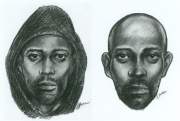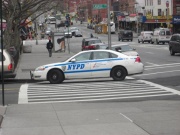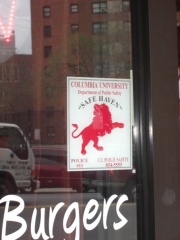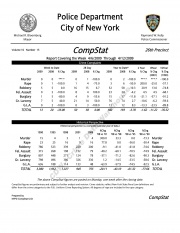From A Neighborhood in Transition
Contents |
Law Enforcement & Criminality
Morningside Heights is a relatively low-crime area, especially when compared to districts such as neighboring Harlem. Since 1993, crime has steadily decreased--cumulatively, an approximate -76.52% change (the number is a total of the percent changes in different types of crime, including murder, rape, robbery, grand larceny, burglary, felony assault, and grand larceny auto). The total number of crimes reported up to this date are 755, as opposed to 3,380 in 1990, and 945 in 2001. The largest change has been in murders, with 0 occurring up to this date and 4 reported in 2008, as opposed to 15 reported in 1990. Though the changes between years have been relatively small, they point to a long-term shift towards a safer environment.
An interview with a Columbia student reveals that though crime does exist on campus, high security measures and community efforts ensure that not only that the prevalence of crime remains low, but that those responsible are disciplined. For example, if a student were to commit a crime in the dormitories on campus, security camera footage would be formatted and distributed campus-wide so as to identify the culprit. Students usually point out the one responsible, and so the system is usually effective.
The Public Safety section of the Columbia website keeps an up-to-date Current Security Alerts list, which lists all recent crimes in or near the Columbia campus, as well as how they develop. These alerts include all kinds of crimes, from a laptop theft in the café(5/11/09) to assault on a female student near an apartment building (4/10/09). The list even includes e-crimes, such as an e-mail scam reported by Medical Center employees meant to steal their bank PINs and card numbers (8/28/08).
Columbia also sponsors a Safe Haven program dubbed the "Lion's Watch." Storefronts and businesses emblazoned with the insignia on their front have been screened by Columbia's Department of Safety. These businesses provide a valuable service to the Morningside populace, allowing anyone to ask the merchant to contact the Department of Public Safety, so that the person may wait there for assistance. Over 50 businesses have been screened & involved in the project. Columbia also maintains a number of police contact boxes on street corners and throughout the area.
View Precinct 26 in a larger map
Interview With Precinct 26
Here is a transcript of an interview with Officer Ondrick of the Precinct 26 station. The following interview does not represent the opinion of the entire precinct house or the NYPD.
- Compared to other precincts (both in Harlem and the rest of the city), how bad is crime in Precinct 26?
Well, it exists. The precinct is definitely not as bad as some other places, like Bed Stuy over in Brooklyn, South Bronx, and even Harlem--crime is relatively low. But I still wouldn't want to live here.
- How serious do the crimes get in the neighborhood?
In my experience, the worst crime I've seen was one homicide 6 months ago. We also had 5 grand larcenies, but that's about it.
- Are there any specific locations in the precinct's neighborhood that see crime more often than others?
Actually, the area where we see most crime is around your school, by where the dorms are. That'd be on 133rd Street. We see alot of robberies take place in that area.
- When has criminal activity been at its highest point?
I'd say the peak hours for crime in the area are at night, between 8 PM and 12 AM.
- What does the future look like in terms of crime? Do you see the general level of crime going up or down?
That kind of thing is really hard to predict. You never know what might cause crime to swing one way or the other, so you can never make a good prediction. But, the crime level here has been going down for a while--every year, it's another couple of percentage points--so we might expect the level of crime to keep going down. But you can never tell in any case.
Crime Statistics for Precinct 26
| These statistics are taken from the 2009 edition of Compstat for Precinct 26, provided to the public by the NYPD Compstat Division. |
|---|

 |
Thoughts
The relationship between an area's economic status, the gentrification of its population, and its crime rate & need for security is not surprising given trends we have seen over time, but is still interesting, especially given a city as diverse and vibrant as New York. We know that higher costs attract those with higher wages, while those with lower wages are pushed out of the community. As prices go up & populations shift, security rises & crime incidents go down. What I find most interesting is the immediacy of he shift between this kind of community, and its direct opposite embodied in the neighboring community of Harlem. As has been described before in this article, the shift between the high-class and low-class communities forms a gradient, as if we were moving from light to dark on a color band. However, this gradient is notable in how palpable it is--you move a few blocks uptown, storefronts change, prices drop, and overall quality of living decreases (in some cases, dramatically). Further, you can see the beginnings of future expansion by the Columbia community into the outlying areas--for example, the Columbia University Employment Information Center on Broadway and 125th Street. The present situation causes me to consider just how far the expansion of high-class trends will reach, but more importantly what will happen to the gentrified population where there is no more room left to move into. Will they simply move where they can sustain themselves, and what would the consequences of this be? Or, will they themselves undergo a shift into a new social strata, and might this possible change be thanks to the institutions dotting Morningside Heights? Is this sort of change good or bad? The future of the area may have been planned out, but its impact is yet to be seen.
References
1. NYPD, CompStat Unit, comp. Compstat, 26th Precinct. Rep. no. 15. Vol. 16. New York City: New York Police Department, 2009. Covers the week 4/6/09 to 4/12/09.
2."Current Security Alerts." CU Department of Public Safety. Ed. Department of Public Safety. May 2009. Columbia University. May 2009 <http://www.columbia.edu>.





